-
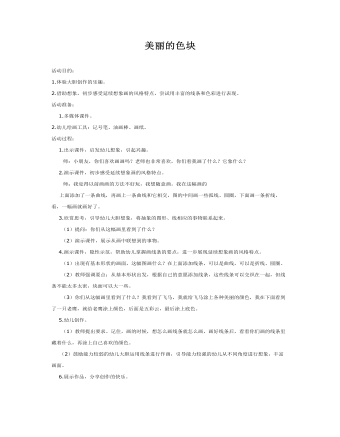
大班美术教案:美丽的色块
2.借助想象,初步感受延续想象画的风格特点,尝试用丰富的线条和色彩进行表现。 活动准备: 1.多媒体课件。2.幼儿绘画工具:记号笔、油画棒、画纸。活动过程: 1.出示课件,启发幼儿想象,引起兴趣。 师:小朋友,你们喜欢画画吗?老师也非常喜欢,你们看我画了什么?它象什么? 2.演示课件,初步感受延续想象画的风格特点。 师:我觉得以前画画的方法不好玩,我想随意画。我在这幅画的 上面添加了一条曲线,再画上一条曲线和它相交,图的中间画一些弧线、圆圈,下面画一条折线,看,一幅画就画好了。
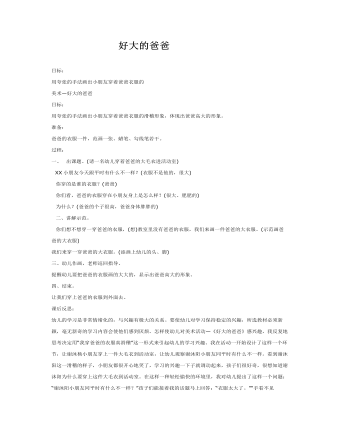
大班美术教案:好大的爸爸
目标:用夸张的手法画出小朋友穿着爸爸衣服的滑稽形象,体现出爸爸高大的形象。准备:爸爸的衣服一件,范画一张、蜡笔、勾线笔若干。过程:一、 出课题。(请一名幼儿穿着爸爸的大毛衣进活动室) XX小朋友今天跟平时有什么不一样?(衣服不是他的,很大) 你穿的是谁的衣服?(爸爸) 你们看,爸爸的衣服穿在小朋友身上是怎么样?(很大、肥肥的) 为什么?(爸爸的个子很高,爸爸身体胖胖的)
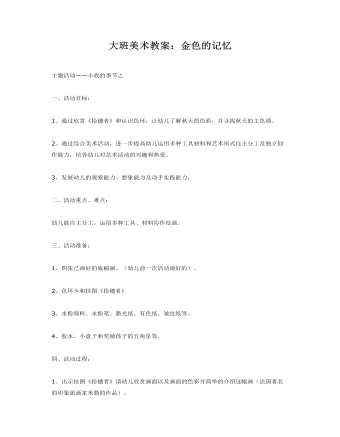
大班美术教案:金色的记忆
一、活动目标:1、通过欣赏《拾穗者》和认识色环,让幼儿了解秋天的色彩,并寻找秋天的主色调。2、通过综合美术活动,进一步提高幼儿运用多种工具材料和艺术形式自主分工及独立创作能力,培养幼儿对艺术活动的兴趣和热爱。3、发展幼儿的观察能力、想象能力及动手实践能力。二、活动重点、难点:幼儿能自主分工,运用多种工具、材料协作绘画。
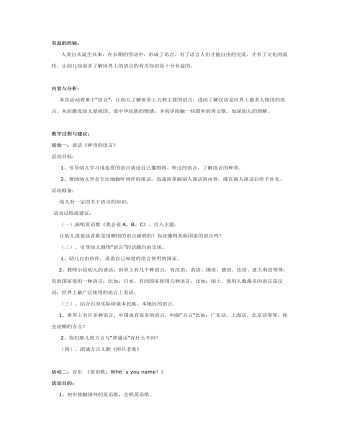
大班语言教案:神奇的语言
内容与分析: 本次活动着重于“语言”,让幼儿了解世界上几种主要的语言,进而了解汉语是世界上最多人使用的语言。从而激发幼儿爱祖国、爱中华民族的情感。并初步接触一些国外的英文歌,加深幼儿的理解。 教学过程与建议:活动一:谈话《神奇的语言》活动目标: 1、引导幼儿学习用连贯的语言谈论自己懂得的、听过的语言,了解语言的种类。 2、帮助幼儿学会专注地倾听同伴的谈话,迅速的掌握别人谈话的内容,能在别人谈话后给予补充。活动准备: 幼儿有一定的关于语言的知识。
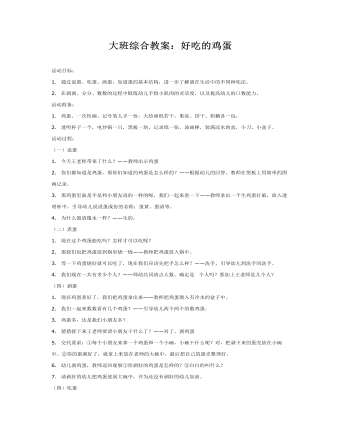
大班综合教案:好吃的鸡蛋
2. 在剥剥、分分、数数的过程中锻炼幼儿手指小肌肉的灵活度,以及提高幼儿的口数能力。 活动准备: 1. 鸡蛋、一次性碗、记号笔人手一份,大绘画纸若干,果冻、饼干、奶糖各一包, 2. 透明杯子一个,电炒锅一只,黑板一块,记录纸一张,油画棒,装满凉水的盆,小刀、小盆子。 活动过程: (一)说蛋 1. 今天王老师带来了什么?——教师出示鸡蛋 2. 你们都知道是鸡蛋,那你们知道的鸡蛋是怎么样的?——根据幼儿的回答,教师在黑板上用简单的图画记录。 3. 那鸡蛋里面是不是和小朋友说的一样的呢,我们一起来看一下——教师拿出一个生鸡蛋打破,放入透明杯中,引导幼儿说说蛋成份的名称:蛋黄、蛋清等。 4. 为什么蛋清像水一样?——生的。
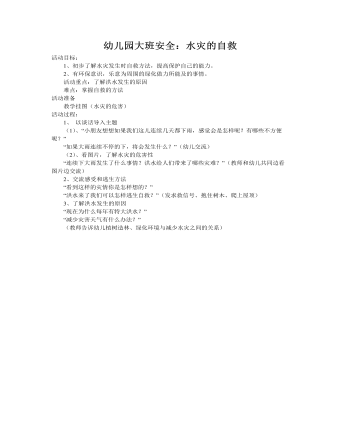
大班安全教案:水灾的自救
2、有环保意识,乐意为周围的绿化做力所能及的事情。 活动重点:了解洪水发生的原因 难点:掌握自救的方法活动准备 教学挂图(水灾的危害)活动过程:1、 以谈话导入主题 (1)、“小朋友想想如果我们这儿连续几天都下雨,感觉会是怎样呢?有哪些不方便呢?”“如果大雨连续不停的下,将会发生什么?”(幼儿交流)
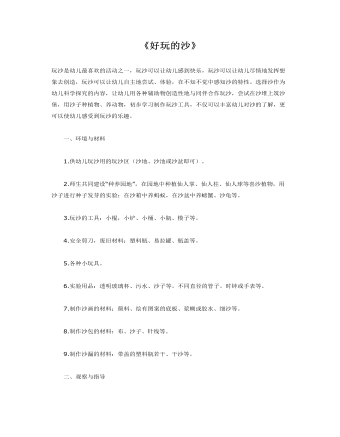
大班体育教案:好玩的沙
一、环境与材料1.供幼儿玩沙用的玩沙区(沙地、沙池或沙盆即可)。2.师生共同建设“种养园地”,在园地中种植仙人掌、仙人柱、仙人球等喜沙植物,用沙子进行种子发芽的实验;在沙箱中养蚂蚁,在沙盆中养螃蟹、沙龟等。3.玩沙的工具:小棍,小铲、小桶、小瓶、模子等。4.安全剪刀,废旧材料:塑料瓶、易拉罐、瓶盖等。5.各种小玩具。6.实验用品:透明玻璃杯、污水、沙子等。不同直径的管子。时钟或手表等。7.制作沙画的材料:颜料、绘有图案的底板、浆糊或胶水、细沙等。8.制作沙包的材料:布、沙子、针线等。9.制作沙漏的材料:带盖的塑料瓶若干、干沙等。
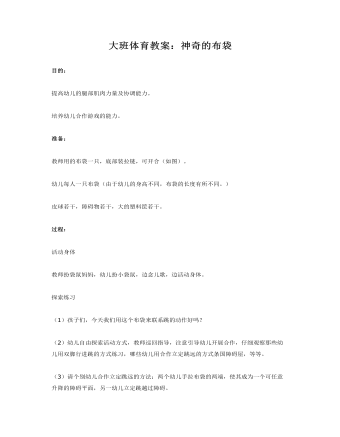
大班体育教案:神奇的布袋
培养幼儿合作游戏的能力。 准备: 教师用的布袋一只,底部装拉链,可开合(如图)。 幼儿每人一只布袋(由于幼儿的身高不同,布袋的长度有所不同。) 皮球若干,障碍物若干,大的塑料筐若干。 过程: 活动身体 教师扮袋鼠妈妈,幼儿扮小袋鼠,边念儿歌,边活动身体。 探索练习
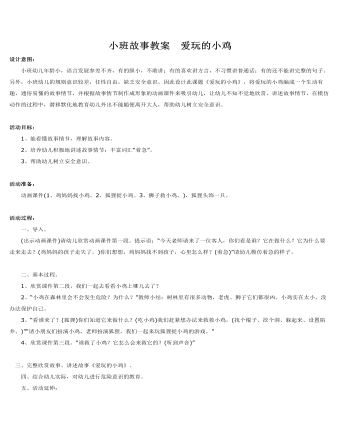
小班故事教案 爱玩的小鸡
活动目标:1、能看懂故事情节,理解故事内容。2、培养幼儿积极地讲述故事情节;丰富词汇“着急”。3、帮助幼儿树立安全意识。 活动准备: 动画课件(1、鸡妈妈找小鸡。2、狐狸捉小鸡。3、狮子救小鸡。),狐狸头饰一只。 活动过程: 一、导入。(出示动画课件)请幼儿欣赏动画课件第一段。提示语:“今天老师请来了一位客人,你们看是谁?它在做什么?它为什么要走来走去?(鸡妈妈的孩子走失了。)你们想想,鸡妈妈找不到孩子,心里怎么样?(着急)”请幼儿模仿着急的样子。

大班陶艺教案:漂亮的家具
2、巩固陶艺活动的各种制作技能及使用工具的技能技巧。3、发展幼儿的创造思维和想象力,体验陶艺制作的乐趣。二、活动准备:1、家具的多媒体展示--VCD一盘。2、泥、泥工板、泥工辅助工具若干。三、活动指导:(一)谈话引题。教师与幼儿共同交谈家里有什么家具?又有什么用?(二)观看家具的多媒体展示--VCD,引导幼儿仔细观察。
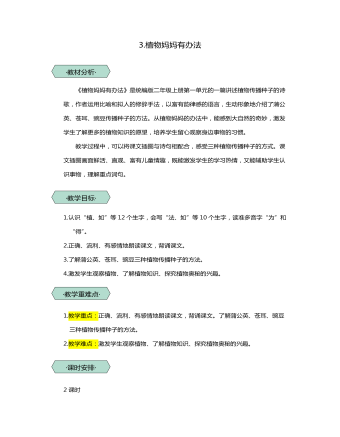
统编版二年级语文上第3课植物妈妈有办法教学设计教案
《植物妈妈有办法》是统编版二年级上册第一单元的一篇讲述植物传播种子的诗歌,作者运用比喻和拟人的修辞手法,以富有韵律感的语言,生动形象地介绍了蒲公英、苍耳、豌豆传播种子的方法。从植物妈妈的办法中,能感到大自然的奇妙,激发学生了解更多的植物知识的愿望,培养学生留心观察身边事物的习惯。教学过程中,可以将课文插图与诗句相配合,感受三种植物传播种子的方式。课文插图画面鲜活、直观、富有儿童情趣,既能激发学生的学习热情,又能辅助学生认识事物,理解重点词句。 1.认识“植、如”等12个生字,会写“法、如”等10个生字,读准多音字“为”和“得”。2.正确、流利、有感情地朗读课文,背诵课文。3.了解蒲公英、苍耳、豌豆三种植物传播种子的方法。4.激发学生观察植物、了解植物知识、探究植物奥秘的兴趣。 1.教学重点:正确、流利、有感情地朗读课文,背诵课文。了解蒲公英、苍耳、豌豆三种植物传播种子的方法。2.教学难点:激发学生观察植物、了解植物知识、探究植物奥秘的兴趣。 2课时
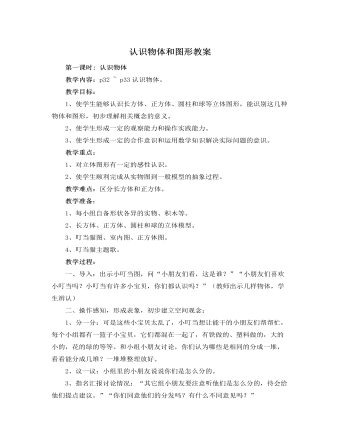
人教版新课标小学数学一年级上册认识物体和图形教案
1.让学生拿出长方体摸一摸,问:你有什么感觉?摸的的面是什么形状?师:谁来摸一摸,老师手上长方体的长方形在哪?(学生找出长方形)2.让学生在自己的学具(长方体、正方体、圆柱体)上找图形,并和小组里的同学说一说。3、指名说,教师把学生找到的图形从立体图形上分离出来,贴于黑板上,师:这些图形是物体上的一个面,这就是我们今天要认识的图形。(板书课题——认识平面图形)4.让学生说说:从什么物体上找到了什么图形?5.师:你能想办法把这些形状画到一张纸上吗?请学生演示各自不同的方法,然后教师在黑板上沿长方体的一个面画出长方形。师:你会画吗?请小朋友们用自己喜欢的办法画出并剪出长方形、正方形、圆和三角形各2个。

人教版新目标初中英语八年级上册Can you come to my party教案3篇
Step 3 (3b)First, tell the students when we talk about our future plans, we often use: I’m+verb+ing When we talk about what we must do, we use have to. Ask the students to fill in the blanks in 3b. The answers are: shopping, go to see, a test, I’m going, my family. Step 4 (3c)Let the students write an e-mail message to a friend. Say why you can’t visit next. Before the exercise, ask the students to give some possible answers and write them on the blackboard. So the students will feel easy to finish the writing exercise. After they finish it, Let them to correct it in groups first. Each group chooses theirs best one to read in front of the whole class. Step 5 ( planning a party )First read the conversation in the box together. Then ask the students to turn to page 88.Write down everything you have to do next week. Write in all the things you have to do . Ask the students to look at the list. Ask them “What day are you free?” This is when you can have your party. Step 6 (Self check 1 )Let the students to fill in the blanks with the words given. Change the forms of the words if possible. Then make their own sentences. The answers are: visit, playing, have to, study, comeStep 7 (Self check 2)Imagine you are Marie. Read the information and look at your schedule. Write replies to the invitation.

人教版新目标初中英语八年级上册How do you make a banana milk shake教案2篇
1. First, ... then, ... next, ... finally, ...首先,……然后,……接着,……最后,……这是英语中表达做某事的步骤的一种说法。如果步骤较多,还可以说:first-next-after that-later on-finally/at last通常你会听到说英语国家的人在说 first, next, then, finally 和后面的内容时,他们会做一些停顿。这样就能提前告诉听者接下来讲的是一系列的步骤。这一点在朗读和听力中应特别注意。2. how many, how much均为疑问词,同是“多少”,但用法不同。请看:how many修饰可数名词复数,how much修饰不可数名词。但在用法上,同学们常犯如下错误:1) [误] How many are there bananas on the table?[正] How many bananas are there on the table?[析] how many, how much 中的many,much是形容词,常修饰名词作定语,故后面跟名词。2) [误]How much tea are there on the table?[正]How much tea is there on the table?[析] how much修饰不可数名词时,谓语动词用单数。how many与how much的区别可简记为:前how many:问“多少”,复数名词后面跑;how much问“多少”,不可数名词单数好。前者答语用基数词,后者答语用数量关系。

人教版新目标初中英语八年级上册How was your school trip教案2篇
“Go for it!” is based on “Task-Based Language Teaching”. It adheres to “The authenticity principle”, “The form-function principle”, “The task dependency principle” and “The principle of learning by doing”. These principles all accord with the demands of curriculum focus.In and of Grade Seven (II), “Go for it!”, students have learned “The Simple Past Tense”. And it appears again in of Grade Eight (I). teaches students more about how to talk about events in the past. In addition, it gives affirmative and negative statements in the past tense, such as the sentence patterns “Did you see …?” “Were there …?” “Did you go …?” As the first part of Unit 8, Section A opens with a picture presenting the last school trip in the aquarium and continues with several step-by-step practice activities, which are all good for students to master “The Simple Past Tense”. Doing well in Section A will help students integrate the new target language with that in Section B. Thus, they can describe the events in the past freely and foster their own ability of reflecting and practicing. II. Teaching ObjectivesTeaching objective is the beginning and aim of teaching activities. According to the overall goal of the English elementary course--- improve students' synthetic ability of language application, which should be based on the development of students’ “Language knowledge”, “Language skills”, “Character building”, “Learning strategies” and “Cross-cultural awareness”. The teaching objectives are described as follows(I). Knowledge objectivesi. Master the simple past tense of regular and irregular verbsii. Recite the new words and expressions about the last school trip in the aquarium, including their pronunciation and intonation

人教版新目标初中英语八年级上册Could you please clean your room教案3篇
一、 教学内容Section A 1a----1c二、 教学目标1.学习词汇do the dishes, make the bed, take out the trash, fold the clothes, do the laundry, sweep the floor, clean the living room.2.句型 Could you please clean your room? Yes, sure.三、 教学准备 学生预习本单元所有的词汇多媒体课件 活动表 奖品四、 教学过程Pre-task1. Warming upEnjoy ourselves. Watch cartoon Cinderella. 看动画片段《灰姑娘》导如入本课话题和新词汇“chores”美丽善良的鬼姑娘因继母的嫉妒,每天得做所有的家务。片段的主题使学生联想到本课的话题。2. learn new words and phrasesLook! What is she / he dong? 看图学习动词词组do chores, do the dishes, make the bed, take out the trash, fold the clothes, do the laundry, clean the living room.3. Guessing game.What is she doing ? 4. Pair work. 1a, Do you do these things at home? Write “Y” for “yes” and “N” for “no”.5. Listening . 1b , Peter’s chores or Mom’s chores?理解目标语Could you please clean your room? Yes, sure.Write “M” for Mom’s chores, “P” for Peter’s chores in the chart.6. PairworkLook at the picture,Ask your partner to do the chores that you see. 7. Interview Who is the most able at home? 1) What chores do you do at home? How often do you do the chores? Work in four, interview each of the students in the group, fill in the chart.

人教版新目标初中英语八年级上册How do you get to school教案2篇
Step Ⅶ Role play ( Work on 1b)1. First ask two students to read the dialogue to the class.Sa: How do you get to school?Sb: Well, I ride my bike to the subway station. Then I take the subway.2. Now work with a partner.Suppose you use two kinds of transportation to get to school \Hangzhou\Beijing... (bus, train, subway, walking, bike, etc.) Tell how you get there. You may use the phrases in 1a.3. Then ask different pairs of students to present their conversations to the class.Step ⅧListening1. Work on 2a(1) First ask students to read the list of information that Thomas wants to know.…where Nina lives.…how far from school she lives.…how long it takes to get to school.…how she gets to school.…what she thinks of the transportation.(2) Tell students what transportation and bus stop mean.bus stop 汽车站 transportation n. 运送;运输Then tell students we'll hear a recording. Please put a checkmark in front of each thing that Thomas wants to know.(3) Now play the recording for students.( Have students pay attention to the sample answer.) (4) Then correct the answers.

人教版新目标初中英语八年级上册What are you doing for vacation教案2篇
Teaching goals : 1. Words & phrases: babysit ,get back , fishing , rent , think about , decide(on) , tourist etc. 2. How to talk about future plans . 3. 现在进行时表示将来计划或行动. 4. 特殊疑问句(where , when , how long引导) Important and difficult points : Drills :What are you doing for vacation ? I’m watching TV . When are you going ? I’m going … . How long are you staying ? We’re staying for five days . Teaching aids : cards and a tape ,a large wall calendar . Period 1 Teaching procedures : Step 1Leading in1. Free talk . 2. Put up the wall calendar . T: I’m staying home on Saturday (pointing to next Saturday ).Ss repeat . Ss: I’m staying home on Saturday . T: OK. Today we’ll learn how to talk about future plans. Step 2Pre-task SB Page 13 , 1a . 1. Look at the picture carefully and tell what you see in the picture . 2. Write the activities from the pictures in the box and add some more . 3. Practice reading . Step 3While-task1. Using the activities we write in 1a to make conversations .For example :What are you doing for vacation ? I’m visiting my uncle . 2. Pairwork .Practice in pairs . 3. 用第三人称练习对话.

人教版新目标初中英语八年级上册I’m going to be a basketball player教案3篇
教学目标1.知识目标:(1)学习What are you going to be when you grow up?/How are you going to do that?句式。(2)学会用英语描述有关职业的表达法。2.能力目标:(1)能够谈论为实现理想所做出的打算和安排。(2)能够谈论未来自己与他人理想的职业及原因。(3)能用英语描述课余时间的活动安排,最终具备表达综合信息的能力。3.情感目标:新学期到来之际,让他们在学习、体育、饮食、特长、读书等方面制定计划,教育学生合理安排自己的课外生活,思考自己的理想职业及适合自己的职业。教学重点、难点本单元的重点为“be going to”表将来,want to be, what,where, when,how引导的特殊疑问句。难点是语言目标的实现。教材分析本单元以I am going to be a basketball player为话题,共设计了三部分的内容:一、Section A该部分有4个模块。第一模块围绕Do you think these jobs are interesting?这一话题展开思维(1a)、听力(1b)、口语(1c)训练;

人教版新目标初中英语八年级下册Have you ever been to an amusement park教案
(1)Have you ever been to …? Yes, I have. / Yes, I have ever been to …No, I haven’t. / No, I have never been to …(2)When did you go there? I went there last year. (3)I have never been to a water park. Neither have I. I have ever been to an amusement park. So have I. (4)How long have you been studying English? I’ve been studying English since nine o’clock. I’ve been studying English since I came back home. I’ve been studying English for five hours. (5)What’s that? It’s an amusement park in Japan. I’ve never been to an amusement park like it before. It’s fun to learn another language. Let’s go tonight. Isn’t this great?space museum, amusement park, water park, South America, Peru, Holland, European culture, tour guide, flight attendant, musical instrument, more than, be from, get to, take lessons, neither, discover, graduate, change